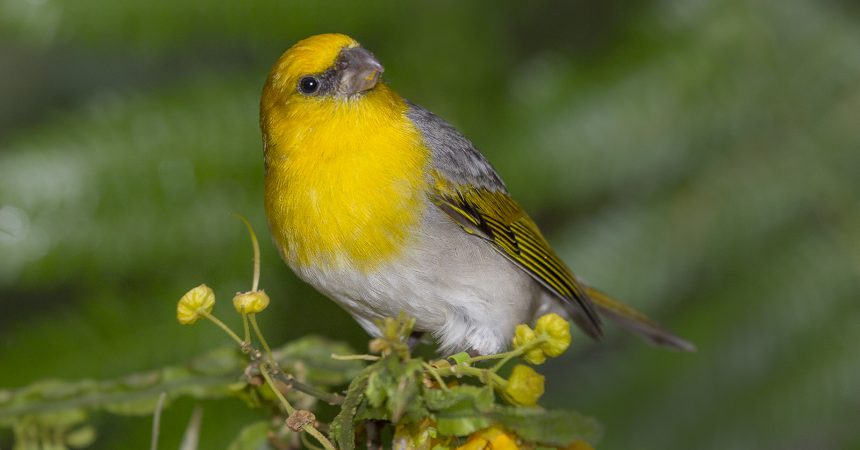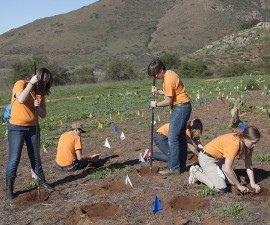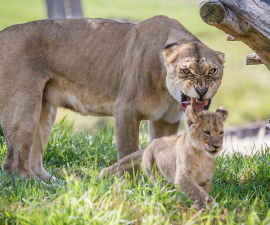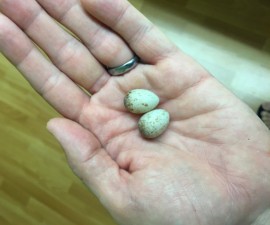Drive a few thousand feet up the slope of massive dormant volcano, Mauna Kea (located on the Big Island of Hawaii) and you’ll discover something rare and unusual. At roughly 6,500 feet in elevation there is a unique type of forest found nowhere else in the world. It harbors many plants and animals only found at this special spot in Hawaii. Unfortunately, one section of the Ka’ohe restoration area doesn’t have much forest to speak of. As far as the eye can see there’s tall, straw colored grass. The only thing that breaks up the landscape is the occasional gnarled tree, looking kind of sad and alone. If you didn’t know any better, you might think you’re in the African Savannah and definitely not Hawaii.
Drought, brush fires, disease, invasive plants, and non-native feral ungulates like mouflan sheep and cattle have left the forest in rough shape. In the midst of this a little bird is paying the price. It’s here in this dry montane forest that one of Hawaii’s most endangered birds, the palila, call home. Their populations have drastically decreased over the last few decades; extreme measures are now being taken to save the species. The Hawaii Endangered Bird Conservation Program (HEBCP) has been breeding the palila in captivity to one day release back into the wild. However, conservation of this spectacular bird requires a multifaceted approach. In order to ensure that releases are successful it is crucial that we make sure the forest is healthy enough to provide the food and shelter the birds need to thrive.
Last spring, a KBCC intern, Emily and I got the chance to glimpse at what life in the wild is like for the palila. We signed up for a volunteer outplanting adventure led by Jackson Bauer from the Mauna Kea Forest Restoration Project (MKFRP) in partnership with the Hawaiian Reforestation Program Foundation. After a fun, rugged four-wheel-drive journey through the restoration area, we arrived at the site where the forest restoration was needed most. Emily, myself, and the rest of the volunteers quickly armed ourselves with the necessary tools, seedlings, and backpacks of water, and set out to plant several hundred seedlings.
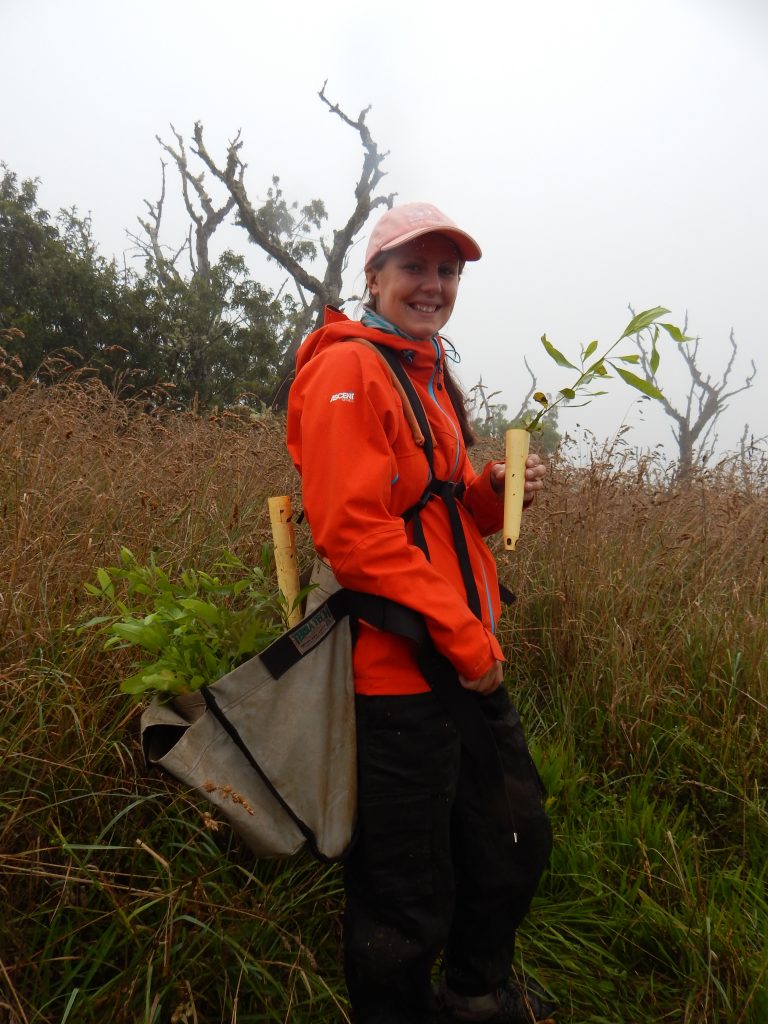
Emily carries a backpack full of ‘a’ali’i seedlings to plant out. The land behind her is covered with tall grass but with some luck, one day it will be a Hawaiian forest once again.
We mainly planted three different plants: ‘iliahi (sandalwood), ‘a’ali’i, and ‘āweoweo, all native Hawaiian flora that make up the forest on this part of the island. We split up into small teams and got to work. One person used a pick axe to pull away the tall grass and expose the dirt. The next person used a dibble stick to make a hole for the plant. Then the seedlings were dropped into the ground and the earth was pressed down around it. Finally, the seedling received a drink of water and we move on to the next planting. By utilizing this division of labor we made short work of what would be difficult for one person to accomplish. In between plantings we had a lot of time to talk, snap some great pictures, and breathe that rich mountain air.
The second part of our adventure was to try and spot a palila or two in the wild. Though there aren’t many of these birds left in the wild, the KBCC staff are no strangers to the palila. We work with them every day—prepping diets, cleaning aviaries, recording behavioral observations, etc. Their calls and songs are imprinted in our minds, as they are the background music we hear every day at work. Seeing a palila at the KBCC is pretty cool, but to see one in the wild is something totally different. To say Emily and I were excited would be an understatement!
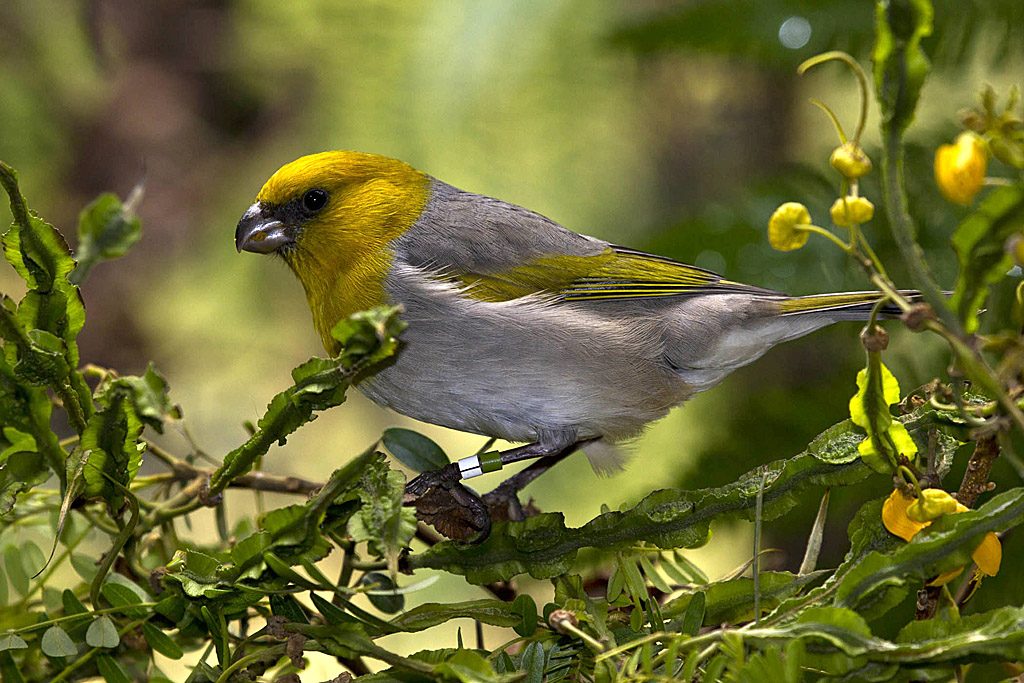
A palila is about the size of a tennis ball. A peek at the palila’s beak reveals why this species is also called a finch-billed honeycreeper.
Jackson Bauer led us up a path through a part of the dense old-growth forest. The group crouched down under a gnarled ‘Iliahi and listened while he shared the palila’s life history. That’s when we heard the unmistakable call of the palila coming from behind us. It was exactly what we hear from the palila in the aviaries. At first the bird was hidden from view—the forest canopy was just too dense. Jackson continued with his story but was quickly interrupted when Emily pointed up to a branch and whispered “Look.” Almost directly above us, in a break in the canopy, was a palila. I held my breath. A majestic male palila! He perched there and silently regarded us for a minute before flying to a nearby tree to join yet another palila! After a few minutes they flew off, but that’s all it took to make all the hard muddy work completely worthwhile.
Thank you to MKFRP for all the work they do to help restore the forest for the palila. It was great to see forest restoration in action and participate in a really rewarding experience. From volunteering to help plant seedlings or making a donation, everyone can help restore this majestic mountain forest back to its former glory.
Amy Kuhar is a research associate at the Keauhou Bird Conservation Center. Read her previous blog, Po Mahina, an Amazing Alala.

